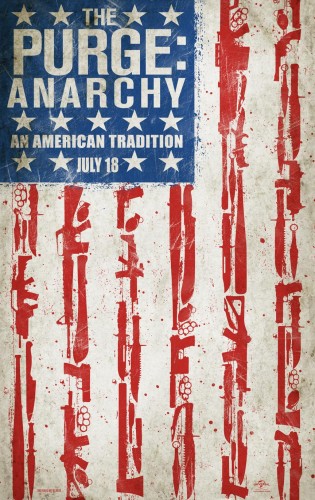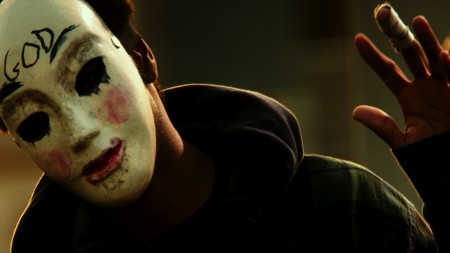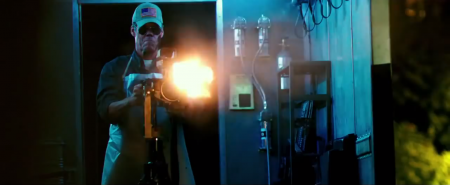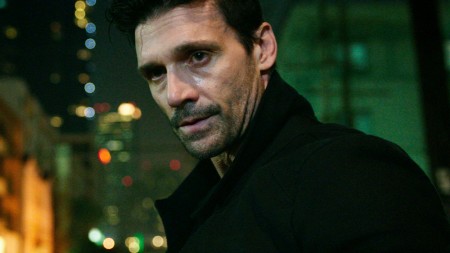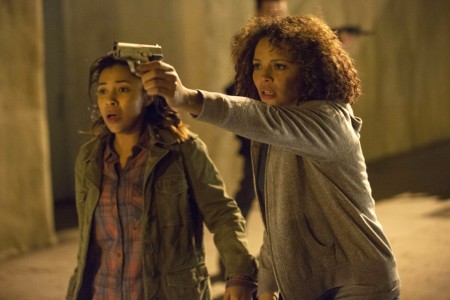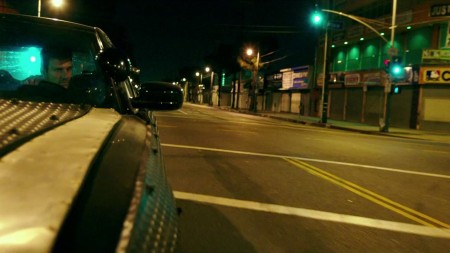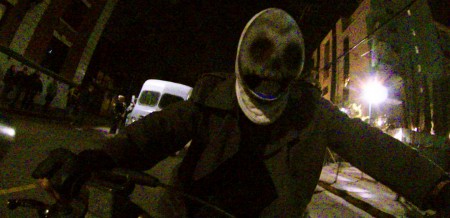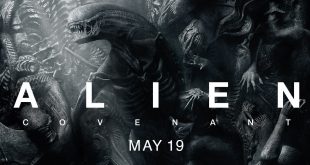SYNOPSIS:
During the annual event known as “The Purge” where all criminal acts become legal for 12 hours, including murder, five innocent citizens of Los Angeles struggle to survive the night. Led by Leo Barnes, a man set out to get revenge, the group includes a troubled couple who are fleeing a group of masked assailants and a mother and daughter escaping a mysterious group who invaded their tenement.
REVIEW:
The Purge: Anarchy improves on The Purge (2013) much like Dawn of the Planet of the Apes does with Rise, however, on a much smaller scale. Director James DeMonaco takes the story of The Purge to the streets planting the audience dead center in the middle of the carnage, violence and mayhem. While Anarchy never reaches for the transcendence of Dawn, it does capitalize on its source material providing exactly what the intended audience is expecting. The Purge is responsible for introducing the concept of 12 hours of no rules where all crime is legal, even murder, but concentrated on a single family in their own home leaving the more intriguing affects and challenges of the larger world to the viewer’s imagination, frustrating many while intriguing others. One year later, DeMonaco returns to deliver on the promises of the first film and, for the most part, does just that. Even when Anarchy is at is most uneven, it still manages to propel itself through the rough spots on its core concept entertaining and delighting its audience.
The annual purge is upon us once again, twelve hours of pure mayhem and violent release. The main story has two sets of characters collide with a well-armed, revenge-seeking police sergeant. Eva and her daughter Cali live in the projects barely making ends meet. They find themselves forced out of the safety of their home when a band of heavily armed men storm their tenement building. Liz and Shane are a troubled couple on their way home to safety, fighting over trivial matters, when their car breaks down miles from their destination and minutes away from the start of the purge. To their horror, a gang of masked thugs on motorcycles watches their every move, ready to pounce at the sound of the sirens. Eva & Cali and Shane & Liz converge on Sergeant Leo Barnes who must decide to help them or ignore their plight in order to continue on his own personal vendetta. The story becomes a fight for survival with twists and turns along the way.
James DeMonaco’s script takes advantage of the high concepts he introduced in The Purge by positioning his characters smack dab in the middle of all the chaos. Carnage is all around them hammering the violence home to the point of near complete desensitization where a flaming bus speeding down the street is part of the norm. To his credit, DeMonaco has a firm grasp on the world he has built for the Purge, a not too far future of American culture. When he touches upon the motivations of certain characters, the story become far more interesting. One group is in it for the money, not the purge; another is under orders to restore the balance and intent of the Purge; and, a third is out to take advantage of their sickest urges all in a “civilized” hunt for the highest bidder. Every vice gets it moment. Regrettably, while he’s at it, DeMonaco forgets to pay attention to the motivations behind his main protagonist until the final minutes of the film resulting in an uneasy shift in tone. Again, much like the original film, the strength is more in the ideas that color the film, that ask interesting and compelling questions, than the stories presented with the characters themselves. Regardless, he is far more successful this go around.
Frank Grillo plays Sergeant Leo Barnes as if lifted straight out of a comic book feeling much like a cross between Captain America and the Punisher — leaning far more toward the Punisher characterizations. For much of the film, Leo has mysterious motivations for being on the streets this purge; but, he is heavily armed and extraordinary capable of holding his own against the various threats roaming the streets blocking his path. He’s out for some sort of purging but refuses to share exactly what. Is he friend or foe? Grillo plays Barnes as morally conflicted giving him a gruff exterior but a compassionate heart as illustrated by his handing over his own bullet proof vest to young Cali even though moments before he threatened to shoot her himself if she does shut up and return to her mother. There’s little doubt he is the “good guy” even if the script wants the audience and the other characters to question his true intentions along the way. Grillo’s best moments are saved for the end when he reveals his purpose and faces the choices of his vendetta head on.
Given that The Purge: Anarchy becomes a survival story of five characters living through the purge, the four innocents under Leo Barnes protection need to gain strength and courage their stereotyped origins would suggest they do not have. The film takes advantage of this toward the end of the film making the most of their plights and harrowing circumstances. Zach Gilford and Kiele Sanchez as Shane and Liz begin the film as an unbearably annoying couple that have the audience begging for their purging as quickly as possible. They are a predictable and trite set of characters that have nothing unique or interesting to bring to the story. It is a testament to Gilford and Sanchez that they breathe any amount of sympathy or empathy into Shane and Liz having the audience root for their survival despite themselves. Carmen Ejogo as Eva and Zoe Soul as her daughter Cali are the stronger characters where they rise above the stereotypes of their characters’ origins. It helps the film greatly that they both share an interesting chemistry with Frank Grillo with Cali equally prodding and admiring Barnes and Eva exerting a reasonable amount of sexual tension. Eva and Zoe are participants in their story while Shane and Liz are more tagging along for the ride.
Playing out like an Escape from New York wannabe, The Purge: Anarchy both expands the world building of its premise and strips away the complexities it implies by focusing on a set group of characters simply fighting for survival rather than diving into the vast, more fascinating moral and political motivations behind the violence, the conficts and the purge itself. When the scripts skirts closer to these elements, it is far more successful than when it is steering its cast away from confrontation to confrontation ala The Warriors (1979). The film kicks into gear during its closing act, elevating the proceeding story and conflicts where the Leo Barnes that finally reaches his goals is far different than the revenge seeking Sergeant that is introduced in the opening sequence. The film has its share of memorable images of the purge and a handful of interesting villains and thugs (the masked motorcycle gang, for example) to satisfy its target audience delivering on the promises made in the first film and expanding on the world of the purge along the way. While not an overly astounding success, The Purge: Anarchy is exactly what it says it will be and is solidly entertaining because of this. Dig to deep into the story and risk peeling away the facade exposing the missed opportunities for deeper exploration of the script’s themes and world building.
3 out of 5
 Horror News | HNN Official Site | Horror Movies,Trailers, Reviews
Horror News | HNN Official Site | Horror Movies,Trailers, Reviews
